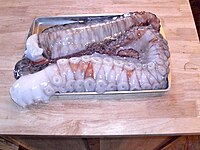Octopus as food
This article needs additional citations for verification. (December 2022) |


People of some cultures eat octopus. The arms and sometimes other body parts are prepared in various ways, often varying by species and/or geography.
Octopuses are sometimes eaten or prepared alive, a practice that is controversial due to scientific evidence that octopuses experience pain.
Dishes by geography
Japan

Octopus is a common ingredient in Japanese cuisine, including sushi, sashimi, karaage, stew, sour salad, takoyaki and akashiyaki.
Takoyaki is a ball-shaped snack made of a
.Korea
In Korea, some small species are sometimes
Maldives
Mauritius
In Mauritius and Rodrigues, octopus, known by its Mauritian Creole name "Ourite" is commonly eaten especially in coastal regions as it is found abundantly in Mauritian waters, although a sharp decline has been observed recently. Popular octopus dishes include the masala octopus curry or boiled octopus in spicy tomato sauce, known as the "Daube".
Mexico
In Baja California, octopus is commonly grilled and eaten on its own or as a component of tacos, tostadas, and ceviche.
Greece
A common scene in the Greek islands is octopuses hanging in the sunlight from a rope, just like laundry from a clothesline. They are often caught by spear fishing close to the shore. The fisherman brings his prey to land and tenderizes the flesh by pounding the carcass against a stone surface. Thus treated, they are hung out to dry, and later will be served grilled, either hot or chilled in a salad. A common preparation technique involves classic Greek spices and seasonings, often including olive oil, garlic cloves, oregano, pepper, and lemon juice.[4] On the whole, octopus is considered a superb meze, especially alongside ouzo.[5]

Spain
Octopus is a very common food in Spanish culture. In the Spanish region of Galicia, polbo á feira (market fair-style octopus) is a local delicacy. Restaurants which specialize or serve this dish are known as pulperías.
Portugal

In Portugal octopus is eaten à lagareiro (olive oil miller style — roasted with potatoes, herbs, onion, garlic, and olive oil),[6] or stewed with rice (arroz de polvo), as well as breaded and then deep fried, with rice and beans.
Tunisia
Octopus is a common food in Mediterranean cuisine such as Tunisian cuisine.
On the Tunisian island of Djerba and Kerkennah islands, local people catch octopuses by taking advantage of the animals' habit of hiding in safe places during the night. In the evening, they put grey ceramic pots on the sea bed. The morning of the following day they check them for octopuses sheltered there. Also unlike its other Maghreb neighbour, seafood, including octopus is used extensively in Tunisia, grilled, roasted, in couscous, pastas or chorbas.
Turkey
In Turkey, octopus is widely used as a food ingredient for mezes. In fish restaurants octopus salad (ahtapot salatası) is one of the most popular cold mezes along with eggplant. Grilled or as a casserole, it can also be prepared hot.[7][8]
United States
Octopus is eaten regularly in
Nutritional value
According to the USDA Nutrient Database (2007), cooked octopus contains about 56 kilocalories (Calories) per 100 grams, and is a source of vitamin B3, B12, potassium, phosphorus, and selenium.[9]
Health Risk
When eating octopus, it is crucial to recognize that consuming mussel tissue carries a very low danger to human health since it contains negligible amounts of metals. Consuming the edible organs of an octopus might possibly have negative effects on health, including the chance of developing renal disease, cancer, and other dangerous illnesses. It is recommended to consider these variables while including octopus into one's diet.[10]
Octopus heads are high in selenium and are a risk for cadmium poisoning, even in small amounts.[11] In 2010, over 29 mg of cadmium—14 times higher than the permitted level—was found in the heads of octopus imported to South Korea from China.[12]
See also
- Eating live animals
- Eating live seafood
- List of seafood dishes
- Pain in invertebrates
- Seafood
- Squid as food
- Squid lū'au
References
- OCLC 56431036. Archived from the originalon 2007-08-25. Retrieved 2012-06-22.
- OCLC 56431036. Archived from the originalon 2007-08-25. Retrieved 2012-06-22.
- ISBN 978-1-74059-977-1.
maldivian cuisine.
- ^ "Grilled Octopus". Archived from the original on 2019-10-01. Retrieved 2018-08-31.
- ^ "Greek Food: Mezedes". www.greecefoods.com.
- ^ "Lagareiro Style Octopus". Cooking Lisbon. Retrieved 16 August 2015.
- ISBN 978-0-85783-596-3.
- ISBN 978-1-64097-141-7.
- ^ "Basic Report: 35054, Octopus (Alaska Native)". USDA. Archived from the original on May 27, 2014. Retrieved 27 May 2014.
- PMID 29603081.
- ^ "Seoul squirms over octopus head war". Reuters. October 21, 2010.
- ^ "Poisonous Cadmium Found in Octopus Heads". Arirang News. September 13, 2010.
External links
 Media related to Octopus as food at Wikimedia Commons
Media related to Octopus as food at Wikimedia Commons Octopus at the Wikibooks Cookbook subproject
Octopus at the Wikibooks Cookbook subproject







